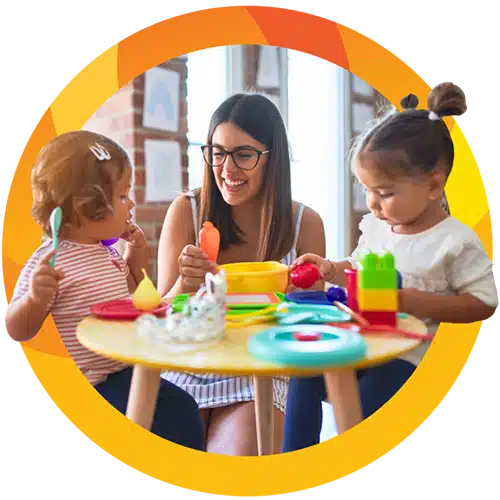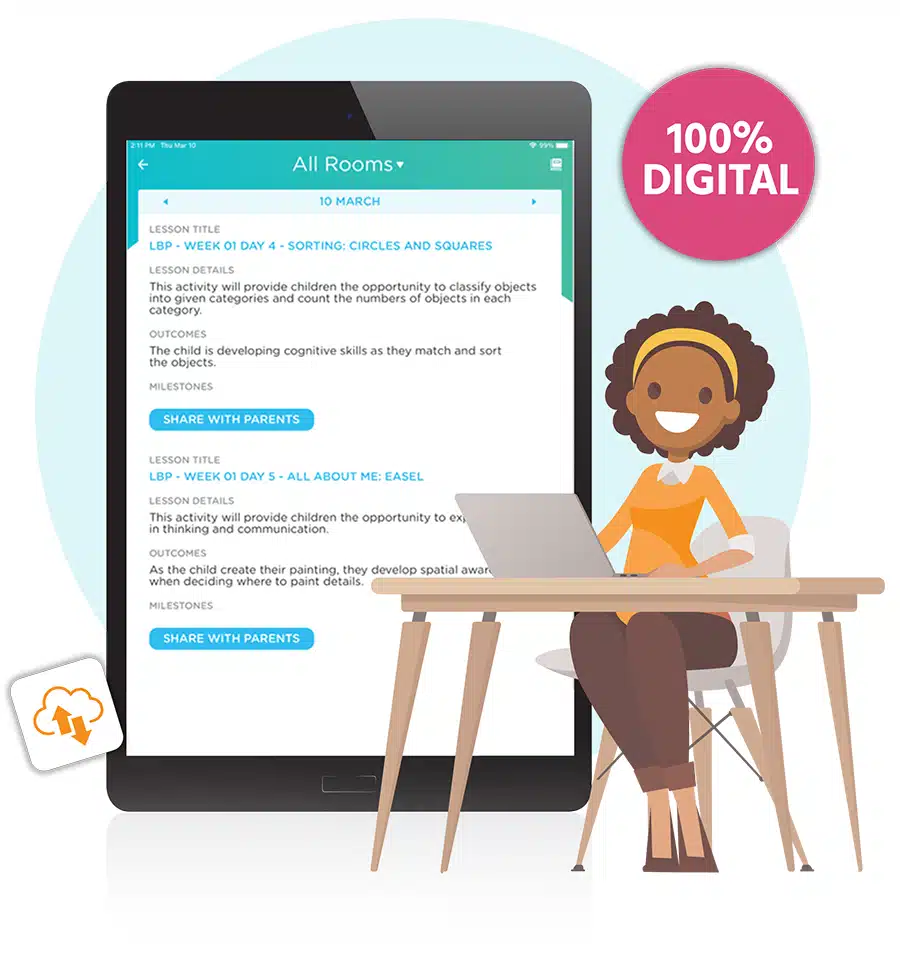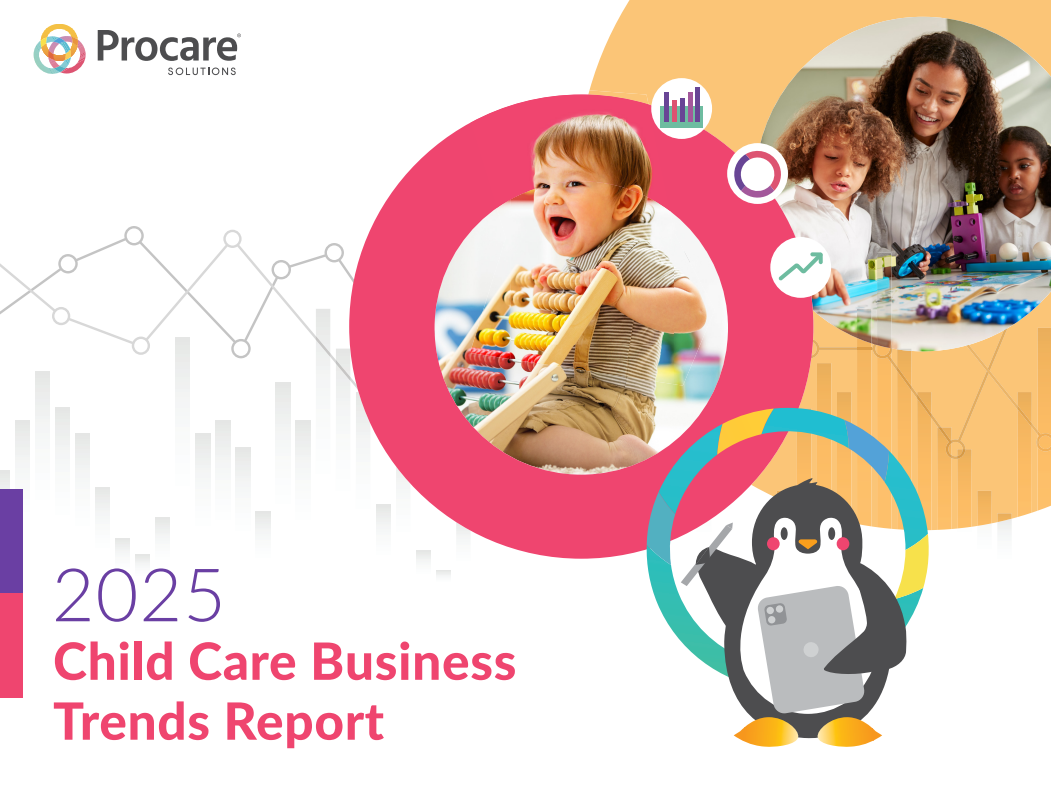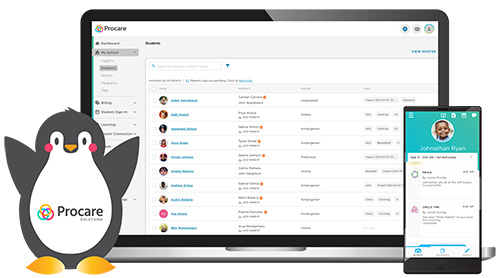This blog was originally posted on April 8, 2021, and updated with new information on March 15, 2024.
As days get busy, it can be easy to group children of different ages together for activities. This is especially true as child care centers struggle with staffing shortages and enrollment fluctuations. But thinking about the toddler age range or the infant age range, it’s important to remember that these ages, and others of course, require different approaches to child care.
Early Childhood Age Ranges
Let’s take a look at the four main early childhood age ranges and daycare ages you need to be aware of, appropriate care techniques for each and the ideal child ratios for every bracket. First up is the infant age range.
1. Infant Age Range: 0-18 Months
Infants can be defined as any child between the ages of 0 and 18 months. Children go through an incredible amount of development in this stage. Infants will learn to roll over, crawl, walk and smile. They may even begin talking.
Your center should encourage these important milestones via age-appropriate educational curriculum, social interaction with other children, new experiences and more.
At the same time, all this development takes a toll, which means your care center’s schedule for the infant age range needs to include plenty of time for babies to rest. Just keep in mind that young infants rarely keep to a consistent schedule and tend to sleep at all times of the day.
The Ideal Group Size: For infants, we recommend a 1:3 child ratio. That means that for every three infants your center cares for, you should employ at least one trained staff member. Check your local regulations to ensure this child ratio is adequate for your area and as a bonus, leverage child care management software to track ratios to ensure you’re always in compliance.
2. Toddler Age Range: 18 Months – 3yr
Toddlers are children between the ages of 18 months and 3 years old. Children at this stage work toward important milestones, too. Some of them include learning to speak, sharing with other kids and becoming potty trained.
Your center should help toddlers reach these milestones, as well as others, by planning engaging activities that stimulate their minds and ensure proper development.
Activities for the toddler age range can include story time, exercise, meal time or anything else that encourages the development of social skills, gross and fine motor skills and language skills.
Unlike infants, most (if not all) of the toddlers you watch should be able to keep to a daily schedule of planned activities. This means that you can plan a much more predictable day for yourself and your kids, which many family childcare providers appreciate.

The Ideal Group Size: For toddlers, we recommend a 1:4 child ratio. For every four toddlers your center cares for, you should employ at least one trained staff member. Connect with your local licensing agency to ensure this child ratio is adequate for your area.
3. Young Children Age Range: 3yr – 5yr
After toddlers comes the young children stage, which can be defined as kids between the ages of 3 and 5. Young children can be given more freedom than toddlers and infants. This independence often leads to increased confidence and skill sets.
For example, young children should be acquiring physical skills like jumping, climbing stairs with alternate feet and properly holding crayons. They should also learn social and mental skills like how to play with other kids, count five to 10 things and follow simple directions.
To help the young children you care for learn essential skills, plan activities such as story time, block play, creative art sessions, music time and more.
The Ideal Group Size: For young children, we recommend a 1:6 child ratio. So, for every six young children your center cares for, employ at least one trained staff member. Check your local child care agency to make sure this child ratio is in line with regulations.
4. School-Age Children: 5yr+

Once kids reach 5, they are considered to be in the school-aged children stage.
This is also a major milestone for your child care center because it means you won’t be watching kids in this age bracket full-time. Instead, you’ll be caring for them before and/or after school and maybe during the summer if you host camps or other summer programs.
Programs for school-aged children should include structured time for homework, fun physical activities and games, healthy meals and the occasional field trip when possible.
Don’t forget, the school-aged children age group is quite large, as it includes kids between the ages of 5 and 12. And there aren’t many 12-year-olds who want to do the same things as 5-year-olds!
So it’s important to provide a wide range of activities for the children you care for and allow them to choose which ones they take part in based on their personal interests. Examples include STEM, art, physical education and community-building activities.
Note: You should still build in time for kids to do their homework, regardless of a child’s personal interests.
The Ideal Group Size: For school-aged children, we recommend a 1:8 child ratio. For every eight children your center cares for, you should plan to employ at least one trained staff member. And as always, check your local regulations to ensure this child ratio is adequate for your area.
Every Child Is Different

It’s important to remember that no two children are the same. While the early childhood age ranges outlined above are good guidelines, not every kid fits perfectly into them. That’s why it’s so important to be in regular contact with the parents of the children you look after.
Give parents regular updates on the development of their child. If necessary, work out custom development plans for children with specific needs.
Age-Appropriate Curriculum Can Help!

Think about how you can set the stage for intentional learning as you make lesson plans. A solid curriculum designed for early childhood education can ensure your children are getting developmentally appropriate activities and learning at the correct age level.
That’s where Procare Early Learning can help. It is seamlessly embedded into Procare, giving teachers everything they need to provide high-quality instruction for infants to pre-K at their fingertips.
You get:
- 52 weeks of lesson plans for five age groups – infant, young toddler, older toddler, preschool and pre-kindergarten
- Over 4,000 daily and weekly activities, with material lists, learning support, social-emotional development and at-home connection newsletters to engage parents
- Lesson plans and daily activities are presented in a developmental progression
- Learning areas including STEAM, language and literacy, physical development, music and movement, cognitive and interactive reading
- Training is built in, with tips and tools teachers can use in real time
Procare Solutions is here to help! Learn more about his s all-digital offering and how it can help you create the best child care for all age ranges!





